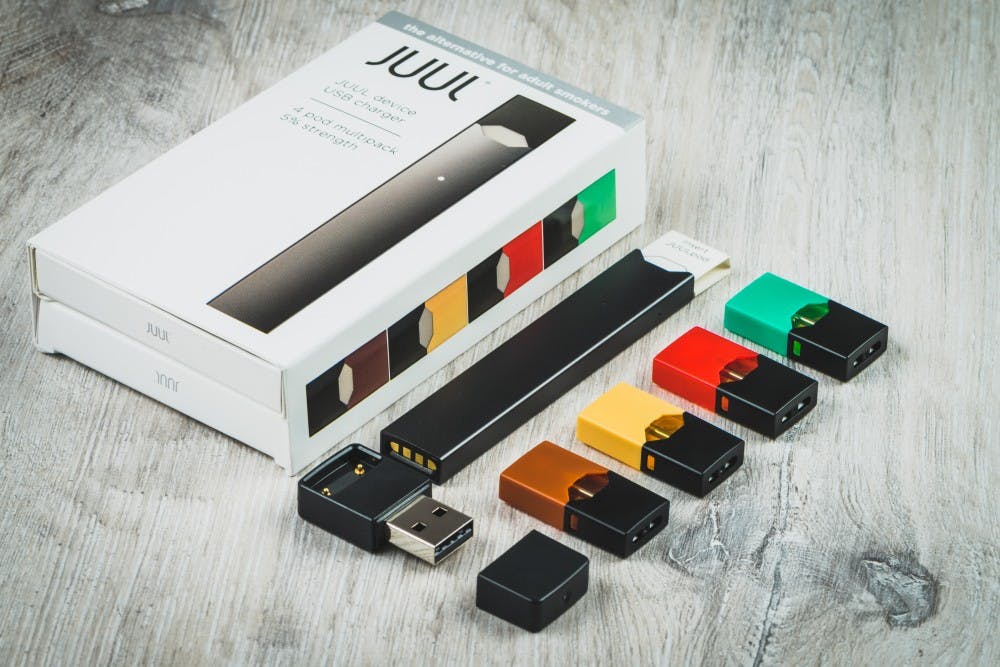
Waiting for the walk sign to switch on at the intersection of 34th and Walnut streets, I took a breath of fresh air and inhaled a familiar essence of artificial fruit. The smell was coming from the guy standing next to me, specifically from his Juul.
Juul has become a sensation on college campuses, and Penn, a supposedly tobacco-free campus, is no exception. Content about Juul floods my social media feed. I log into Facebook and see a post about Juuling from “Overhead at Penn,” maybe another from “Official Unofficial Penn Squirrel Catching Club,” and one more from “Elitist Memes for Every Ivy League Teen.” Penn’s “Free & For Sale” group page even featured a post selling a Juul. An Instagram search for “#Juul” reveals hundreds of thousands of posts. One post featured a kitten Juuling — sickening, in my opinion.
Even as a non-Juuler, I find myself chuckling at certain Juul-related posts. In the minds of most college kids, Juuling is nothing serious. This attitude is pervasive not only on the university level, but in high schools and middle schools. Some schools have chosen to remove bathroom doors in the hopes of catching students in the act. The fact is, Juuling is a health epidemic.
Juul was founded by two former smokers, who envisioned their e-cigarette as an alternative for adult smokers. Each 5 percent “Juulpod” contains approximately 0.7mL with 5 percent nicotine by weight, and one Juulpod is intended to last approximately 200 puffs — the same number of puffs as smoking a pack of cigarettes.
Its list of ingredients is short: glycerol, propylene glycol, nicotine, benzoic acid, and flavorings. Glycerol and propylene glycol are used in vaporization liquids and a number of consumer products, like toothpaste. Benzoic acid is found in the tobacco plant, and it is also a common food preservative.
Short and sweet — it might seem. However, Juul is far from harmless. Though there isn’t the tar that causes most of the health concerns from traditional cigarettes, Juul has a much higher concentration of nicotine, which is highly addictive and known to impair brain and lung development if used during adolescence and young adulthood.
The prefrontal cortex of the brain, which is involved with behavior and personality, is not fully developed until the age of 25. Nicotine activates receptors that regulate feelings of pleasure, and a constant use of the stimulant will alter the still-developing brain cells of young people. More receptors will have to be be produced to handle the nicotine levels the brain has come to expect. As a result, nicotine users, including Juulers, are easily susceptible to addiction hit after hit.
Addiction is costly. One starter kit, including a rechargeable Juul device, a USB charging dock, and four Juulpods, retails for $49.99. A pack of two pods sells for $9.99 and four-packs are $15.99. Juuling is a costly lifestyle, with the average smoker spending $180 per month on Juulpods. That’s $2160 per year — an amount one could use toward a car, a 10-day trip to Morocco, or better yet, student loans. It’s an amount that should not be accounted for in monthly financial budgets, especially not as a college student.

Vaping360 // CC BY-ND 2.0
Additional side effects experienced by Juulers include a persistent cough, bronchitis, congestion and phlegm buildup. These are health concerns that can easily be prevented by putting down your Juul.
A large percentage of young Juulers are uninformed about Juul’s harmful health effects. For teens who smoke e-cigarettes, 66 percent believed their e-cigarettes just contained flavoring. This misconception has arisen from social media posts that only portray the romanticized version of Juuling: Blowing smoke rings is harmless fun.
The health and lifestyle issues speak otherwise, and this past November, Kevin Burns, CEO of Juul Labs, acknowledged Juul’s overuse among today’s youth, saying that they “don’t want anyone who doesn’t smoke, or already use nicotine, to use Juul products.” Juul Labs have stopped accepting retail orders for mango, fruit, creme (formerly creme brulee), and cucumber pods — flavors that are popular among youth. They’ve restricted sales of certain flavors through a secured website that allows access to only people 21 and over. In retail stores and specialty vape shops, only tobacco and menthol-based products will be sold. Juul Lab’s official Facebook and Instagram accounts have been shut down, and they have begun monitoring inappropriate material from third-party accounts.
Juul Labs have made their efforts. We should, too.
I’m not advocating for the outlaw of Juuling because Juul is certainly a godsend for people who have spent years, sometimes lifetimes, trying to quit smoking. In fact, for its target audience, Juuling, along with other forms of e-cigarettes, can be life-saving. According to a New Yorker article, 6.6 million lives would be saved if 10 percent of American smokers switched to e-cigarettes each year in the next decade.
Juuling is not cool. It’s not something to brag about on social media. It’s certainly not something to encourage other fellow students, friends, or family members to try. As the new year approaches, Juulers, do yourselves a favor and write down “give up Juuling” as a resolution. Your health may seem indestructible at the moment. It isn’t. Start taking care of yourself and stop twisting the original mission of Juul. Let’s all just take a breath of fresh air.

CHRISTY QIU is a College freshman from Arcadia, Calif. studying architecture. Her email address is christyq@sas.upenn.edu.
The Daily Pennsylvanian is an independent, student-run newspaper. Please consider making a donation to support the coverage that shapes the University. Your generosity ensures a future of strong journalism at Penn.
Donate






